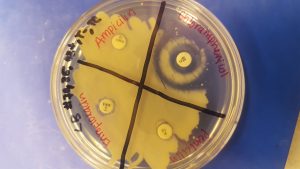Here’s a story that combines two of my favorite topics these days, microbes and space. In this case students from Japan are building a special satellite to house and photograph slime mold growth (Dictyostelium discoideum). I’m not sure exactly what they’ll learn from this, but it sounds cool! Pictures and data will be publicly available …
Quick post here (crossposted from my Tree of Life blog). Our Project MERCCURI got some press coverage relating to an event July 20th with the Arizona Cardinals: Gilbert, Tempe participate in national microbe-swabbing project – East Valley Tribune: Gilbert. From the article: “The event – held at the Arizona Cardinals’ training facility on July 20 – …
Had to post about this recent paper that came out in PLOS ONE, “Spaceflight Promotes Biofilm Formation by Pseudomonas aeruginosa“. Obviously we’re thinking a lot about bacterial activity in space, apropos of our Project MERCCURI work. Really the title says it all here. Biofilms are awesome. Space is awesome. Turns out that biofilms in space …
In my last two posts I described the process of developing the microbial growth experiment we will be running aboard the International Space Station. We’ve tackled growth assays on 96-well plates in zero gravity, at least in theory. How well will this actually work on aboard the space station? To find out, Jenna, Wendy and …
Microtiter plate readers are often used for measuring optical density in liquid media, and this is what we were planning to do. However, they are general purpose, programmable instruments, and there’s no rule that says you have to use them this way. It occurred to me that all of our problems stemmed from the difficulties …
Here is a conundrum: Suppose you want to measure growth rates of bacterial cultures in an aerobic environment, on LB, in 96-well plate format. So, you buy some plates from your favorite supplier, dispense some LB into the wells with a multichannel pipetter, inoculate from whatever your source is, and pop it into your plate …
Does heavy drinking affect the bacteria in your living room air? I don’t know, but some work I saw at ASM suggests that it might. At the poster session on Day 3, Valdis Krumins from Rutgers had a poster reporting efforts to understand the effect on airborne bacterial concentrations (or, at least, their ribosomal 16S …
Just kidding; I paid to get in, but this conference is not intended for a research architect/building scientist like me. This was my third ASM meeting, and now I know something approaching 1% of the jargon, so I was able to “mine” the sessions, especially the posters, for built-environment-relevant content. Under the surface of the …
The Alfred P. Sloan Foundation has created a new funding opportunity in its Microbiology of the Built Environment (MoBE) program. The Foundation seeks to further the development of talented early stage Ph.D. scientists and engineers by establishing the Microbiology of the Built Environment (MoBE) Postdoctoral Fellowship program. The program will provide support for postdoctoral researchers …
In their just published paper in Environmental Science & Technology, “Tetracycline Resistance and Class 1 Integron Genes Associated with Indoor and Outdoor Aerosols,” Alison L. Ling, Norman R. Pace, Mark T. Hernandez, and Timothy M. LaPara have found that genes escape the indoor environment and can be found 2 km away. The abstract can be …
